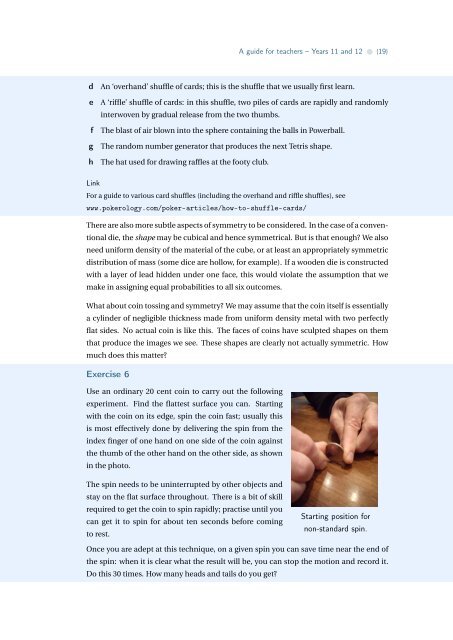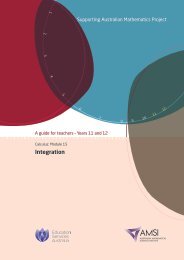Probability - the Australian Mathematical Sciences Institute
Probability - the Australian Mathematical Sciences Institute
Probability - the Australian Mathematical Sciences Institute
- No tags were found...
You also want an ePaper? Increase the reach of your titles
YUMPU automatically turns print PDFs into web optimized ePapers that Google loves.
A guide for teachers – Years 11 and 12 • {19}defghAn ‘overhand’ shuffle of cards; this is <strong>the</strong> shuffle that we usually first learn.A ‘riffle’ shuffle of cards: in this shuffle, two piles of cards are rapidly and randomlyinterwoven by gradual release from <strong>the</strong> two thumbs.The blast of air blown into <strong>the</strong> sphere containing <strong>the</strong> balls in Powerball.The random number generator that produces <strong>the</strong> next Tetris shape.The hat used for drawing raffles at <strong>the</strong> footy club.LinkFor a guide to various card shuffles (including <strong>the</strong> overhand and riffle shuffles), seewww.pokerology.com/poker-articles/how-to-shuffle-cards/There are also more subtle aspects of symmetry to be considered. In <strong>the</strong> case of a conventionaldie, <strong>the</strong> shape may be cubical and hence symmetrical. But is that enough? We alsoneed uniform density of <strong>the</strong> material of <strong>the</strong> cube, or at least an appropriately symmetricdistribution of mass (some dice are hollow, for example). If a wooden die is constructedwith a layer of lead hidden under one face, this would violate <strong>the</strong> assumption that wemake in assigning equal probabilities to all six outcomes.What about coin tossing and symmetry? We may assume that <strong>the</strong> coin itself is essentiallya cylinder of negligible thickness made from uniform density metal with two perfectlyflat sides. No actual coin is like this. The faces of coins have sculpted shapes on <strong>the</strong>mthat produce <strong>the</strong> images we see. These shapes are clearly not actually symmetric. Howmuch does this matter?Exercise 6Use an ordinary 20 cent coin to carry out <strong>the</strong> followingexperiment. Find <strong>the</strong> flattest surface you can. Startingwith <strong>the</strong> coin on its edge, spin <strong>the</strong> coin fast; usually thisis most effectively done by delivering <strong>the</strong> spin from <strong>the</strong>index finger of one hand on one side of <strong>the</strong> coin against<strong>the</strong> thumb of <strong>the</strong> o<strong>the</strong>r hand on <strong>the</strong> o<strong>the</strong>r side, as shownin <strong>the</strong> photo.The spin needs to be uninterrupted by o<strong>the</strong>r objects andstay on <strong>the</strong> flat surface throughout. There is a bit of skillrequired to get <strong>the</strong> coin to spin rapidly; practise until youcan get it to spin for about ten seconds before comingto rest.Starting position fornon-standard spin.Once you are adept at this technique, on a given spin you can save time near <strong>the</strong> end of<strong>the</strong> spin: when it is clear what <strong>the</strong> result will be, you can stop <strong>the</strong> motion and record it.Do this 30 times. How many heads and tails do you get?
















